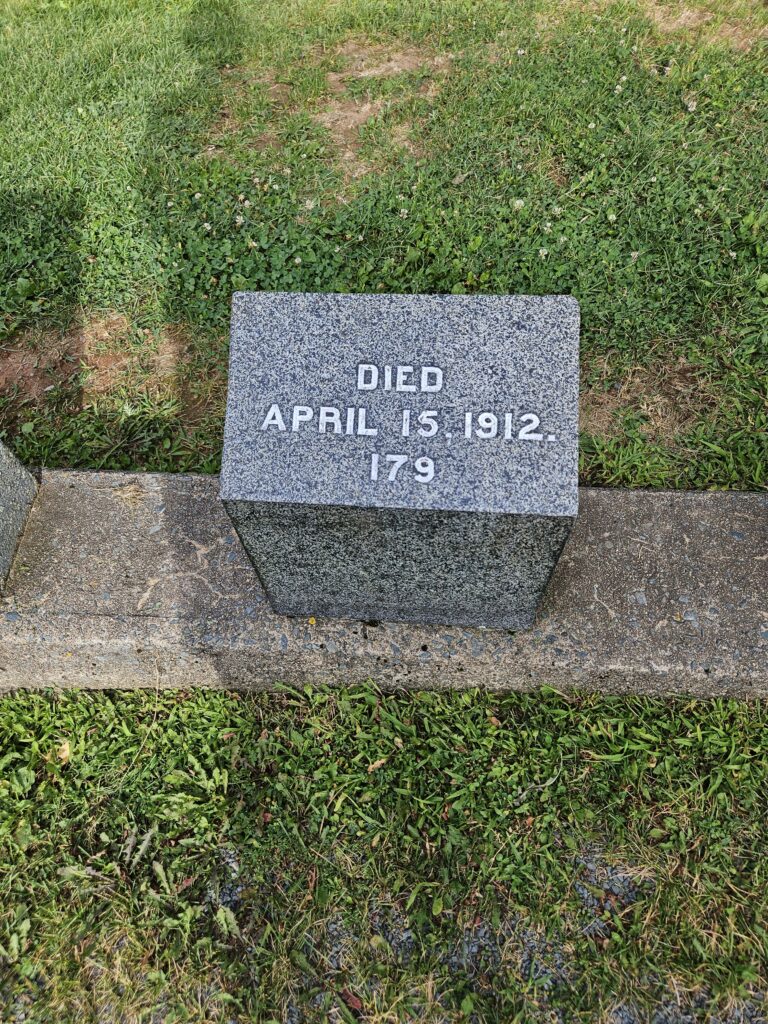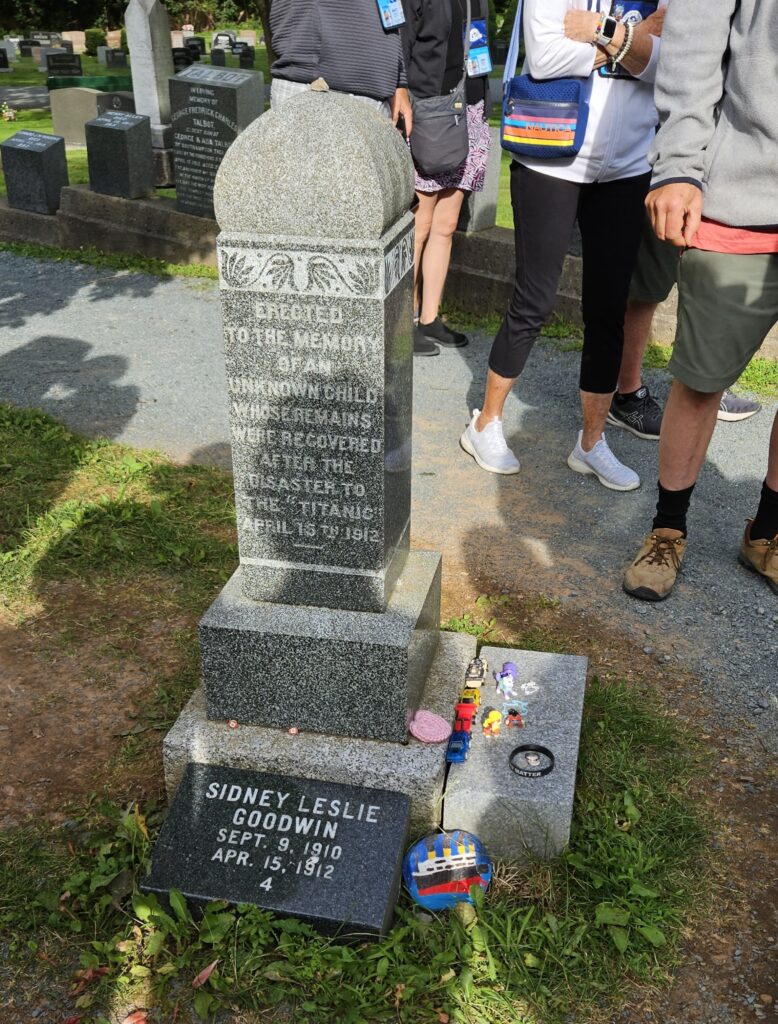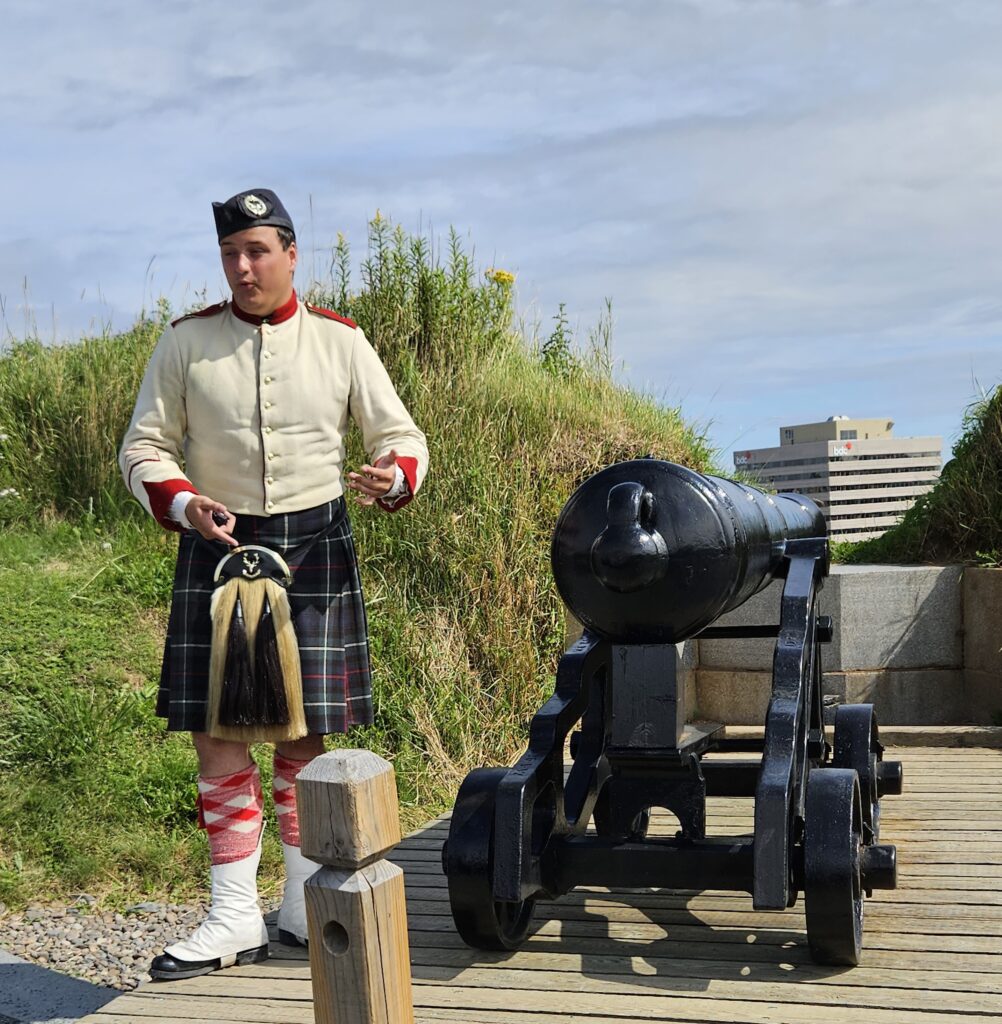
It’s bus tour day!!! Pam picked a fair playing card, a 10. Nothing to brag about though, still in the rear of the bus.
Halifax and the Titanic?
Our first tour stop was the Fairview Lawn Cemetery.
I was clueless about how Halifax was involved in the Titanic tale. Leonardo never mentioned it. The Titanic story that I know goes like this, on April 14th 1912, 4 days after the “unsinkable” Titanic left on her maiden voyage, the ship hit an iceberg. There were 2200 passengers on board and in less than 3 hours the ship sank. 1500 lives were lost.

And now more to the story. 4 fishing boats, 3 out of Halifax, were chartered to sail to the disaster site and retrieve the dead. It was a long sail from Halifax to the disaster site. Fully aware of the icy waters they did not expect to, nor did they, find any survivors.
Upon arrival to the scene, the ships’ captains and crew were traumatized by the sight of the bodies floating upon the sea. When it became clear that all the bodies would not fit aboard the 4 boats, their depression increased. The captains made the gruesome but necessary plan to retrieve, wrap in sails and number those bodies that could be identified. If room allowed, some that could not be identified would also be included in the sail back to Halifax.
The crew did their best to find distinguishing markings, papers, personal belongings or any detail that would help to identify each victim. They recovered 328 bodies. The scores of others that would not fit and could not be identified were given a burial at sea. It was a haunting experience for the captains and crew.
Of the 328 recovered and taken to Halifax, many were processed by forensics teams and identified. When possible, remains were returned to family members. The rest were interred at 3 cemeteries. Fairview Lawn Cemetery became the final resting place of 150 of the Titanic victims.
Although my photographic skills are not the best, trust me when I say the headstones are laid out in the shape of a ship.

Those victims who were never identified are still a mystery with only the date of death and the victim number on the headstone.

However, they have not been forgotten. Researchers using Ancestry.com, DNA evidence and perseverance have uncovered nuggets of information that connects the unforgotten with their name and heritage. The most recent discovery involved an old photo found by relatives that helped identify this 2 year old boy who was previously an unknown child.

After the cemetery, we rode to the Public Gardens and enjoyed a beautiful experience walking the grounds.


From the gardens we went to the Citadel.

Yes, another fort. The volunteers were dressed in full garb. Cannons boomed,

shots were fired

and bayonets were hoisted.

Here are 2 interesting facts that remain in my sifting brain.
Fact #1 The beds for the men were the size of oversized twin beds. There were about 25 beds lined up in a large otherwise empty room. Each bed accommodated 6 men. 3 were on duty and 3 huddled together to stay warm during their short rest time.
Fact #2 We often see in movies or read in books about grog, rum, wine or mead being served to the men on ships or in forts. I always thought the alcoholic beverage was a treat for working hard or winning a battle. That wasn’t it at all. Do you know why high test spirits were served? Think about it and I’ll tell you at the end of this post.
On to the Maritime Museum.

The museum had some beautiful antique boats on display.

The museum had an entire floor dedicated to Titanic artifacts and stories.

There was another Halifax story included in the tour and I’m sorry to say that the telling is another shattering account of history. I usually try to keep my blogs light. However, there are times when I learn of an event that I find historically significant and it touches me in some way. And aren’t you lucky that I impart my new found wisdom on you?
The Great Halifax Explosion
Behind the museum is the Halifax Harbor, there is a strip of waterway that is called The Halifax Narrows. The name Narrows says it all.

During World War 1, Halifax was a very busy port that received ships with supplies from Europe. As ships entered the narrows from the Atlantic and others departed the harbor for the Atlantic, the captains (here we go with the captains again) communicated with each other. Together they determined which ship, the one coming or going, would enter the Narrows first and on which side of the harbor. That’s what was supposed to happen.
So let’s dial back to December 6, 1917. The Mont Blanc, a French cargo ship was entering the harbor. A Norwegian vessel was leaving. The ship captains had what would be a catastrophic communication mishap. Both ships approached the harbor on the same side of the narrows. By the time they tried to adjust, it was too late and the ships collided. A fire broke out on the Mont Blanc. Firefighters began desperately to douse the flames.
The Mont Blanc Secret
What most people did not know was the Mont Blanc was secretly carrying ammunition and explosives equivalent to a 3-kiloton bomb. Uninformed of the dangerous cargo, instead of running for safety, people from around the city came pouring to the port to see the fire blazing in the harbor.
A Hero
One telegraph operator, who knew of the cargo, was about to leave his station for safety but remembered there was a passenger train on its way to Halifax with 300 people aboard. Knowing a major explosion was imminent, he stopped and sent a message “Hold up the train. Munitions ship on fire in harbor and will explode. Guess this will be my last message. Goodbye boys.” The train stopped and the passengers were saved but it was telegrapher’s last message.
The Mont Blanc exploded. Clouds of hot gas rose into the sky and tidal waves erupted from the sea. 1900 people were killed immediately. 9000 were injured and every building in the entire north end of Halifax, was completely destroyed, vaporized. For years the explosion that changed Halifax was quietly remembered. There weren’t yearly memorials to remind the survivors of the death and destruction. But in 1994, the Halifax Maritime Museum determined that it was time to commemorate the disaster with a permanent exhibit.
Our tour of Halifax was complete. The bus was parked in front of the Maritime Museum. Some of our caravanners left the museum early and found a distillery where they had tastings. I cannot believe that nobody mentioned this fact to me. 5 minutes before the bus was about to leave, the word was out. With one foot on the bus entry, I said, I have 5 minutes right? I ran across the street and into the distillery. How many shots are in a tasting, I asked. 4 shots. I have 5 minutes. Line them up please.

Tomorrow we are headed to Prince Edward Island. Did you watch Anne with an E on Netflix, Have you ever had PEI mussels? Do you enjoy Celtic music? Even if you don’t, you’ll want to come along. PEI is really a fun province.
Why Rum, Mead, Ale?
In the 17 and 1800’s there wasn’t any water purification. Drinking water came from rivers and lakes. It was often contaminated and couldn’t be trusted. But when water was processed as Rum or some other alcoholic beverage, the drink became safe alternative to water.
Thanks for the history Guys🙋♀️wonderful pictures puts it all together😎
Especially love the shots at the end😋
Hi Diane, Pam tells me you and George have been camping and George is catching some fish. That’s great! Glad you’re enjoying the blog. Pam and I keep talking about how much we have learned on this trip. I guess I should have paid more attention in history classes. For some reason, it is all more interesting now. We’ll be home in a week and a half so we’ll see you soon.
So much death and disaster in such a short period of time. We also visited the same cemetery on our brief visit to Halifax. So harrowing to see the unnamed graves of children. I hadn’t considered what a terrible job it must have been for the ships who brought the bodies back to dry land. My lasting memory is of a city with a lot of pretty parks.
Yes, Halifax was a sad day of touring. But we ended on a high note with a delicious lunch. I’m not much of a city person so I enjoyed the small towns best, St. Andrews and St. Martines, my two favorites and all of PEI. Almost home. We’ll talk soon.
Another great post!!!! Can’t wait to see your PEI post.
Hi Janet, How does it feel to be home? We are ready. Stopping in Highlands to see Jim and Lisa on Tuesday. Trying to do a few posts before then. Glad we have done some of the same things. It will be great fun to talk about when we see each other.